Unlocking the potential for your outdoor space begins with a vision. We’re sure you’d love a place where warm sunlight dances on your skin, conversations flow freely, and you can just… relax. Once you’ve found the perfect decking, your dreams of transforming your back garden into a sanctuary of comfort and style can start to blossom.
But before you roll up your sleeves and embark on this exciting journey of designing your garden, there’s a fundamental question that lays the foundation for your project’s success: How many decking boards do I need?
Whether you’re a seasoned DIY enthusiast or a first-time outdoor renovator, accurately measuring and calculating the number of decking boards required is an important step. And with this handy guide, we’ll walk you through how to measure for decking quickly and easily without a decking calculator. So, let’s grab your measuring tape, pencil and paper and help you bring your decking vision to life!
Table of content
- How to work out measurements of an area
- How wide or long is a decking board?
- How much decking do I need?
- What size gap should I leave between decking boards (mm) in the UK?
- How much is decking per m2 in the UK?
- Final thoughts
How to work out measurements of an area
We’re sure you’re ready and raring to go, but before you start selecting materials and envisioning your design, hold your horses! It’s crucial to gather accurate decking measurements of the area you plan to cover. A precise measurement will ensure a seamless fit and polished final result for your project. Here’s a step-by-step (or plank-by-plank) guide to help you work out the measurements of your decking area:
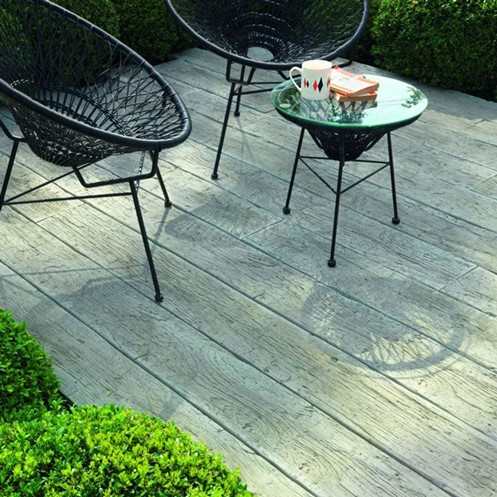
Step One: Clear the space
Begin by removing any furniture, plants or obstacles from the area where you intend to build your decking. This will give you a clear and unobstructed view of the space you’re working with.
Step Two: Define the boundaries
Mark the boundaries of the area using stakes, markers or even branches you’ve found in your garden. This will help you visualise the exact dimensions you need to measure. If your decking will have irregular shapes or include curves, outline those shapes clearly.
Step Three: Measure length and width
Use a tape measure to determine the length and width of the area. Measure from the outer edges of your defined boundaries. Make sure to measure multiple times to ensure accuracy.
Step Four: Account for obstructions
If there are any permanent fixtures within the area, such as trees, posts or built-in structures, measure their dimensions and locations accurately. This information will help you plan your decking layout around these obstacles.
Step Five: Calculate square metres
To calculate the square metres of the area, multiply the length by the width. This will give you the basic area size that your decking will cover. Typically, tape measures are in centimetres, so once you’ve multiplied the dimensions together, divide your calculation by 10,000. Otherwise, your measurements will be in centimetres squared (and you might end up with a few thousand more decking boards than planned)!
Step Six: Allow for overhang
If you’re planning to have an overhang, as many decks do, remember to include this in your calculations. Overhangs not only add aesthetic appeal but also provide functional space for seating and other activities.
Step Seven: Account for stairs and railing
If your decking will include stairs or railing, factor in their dimensions as well. Stairs require careful measurement of their width, height and length. Railing will influence the overall perimeter measurement, adding to the size of your decking.
Step Eight: Plan for waste
It’s good practice to account for some extra material for waste, cutting and potential mistakes. Adding a waste factor of around 10% to your measurements can prevent you from running short on materials during the construction phase.
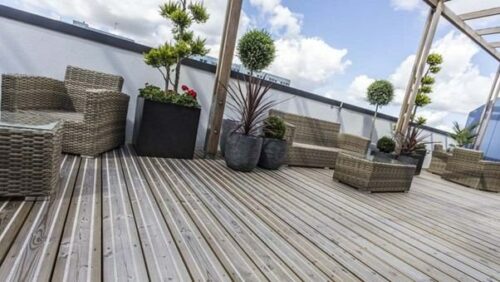
How wide or long is a decking board?
We’re sure you’ll want to correctly calculate how many decking boards you need for your project. Decking boards come in a variety of lengths and widths, and selecting the right size can significantly impact the overall look and feel of your outdoor space. Let’s step into the world of decking dimensions:
Decking board width
Commonly, decking boards are available in widths ranging from 100mm to 200mm or sometimes even wider. The standard width is 150mm, but wider boards, often referred to as “planks”, can provide a more contemporary and visually appealing look. Wider boards can also reduce the number of seams and joints in your deck, creating a cleaner and more polished appearance.
Decking board lengths
Decking boards are typically available in lengths ranging from 2400mm to 4800mm or more. Longer boards can create a more seamless look as they span a larger area without the interruption of seams. However, longer boards may also be heavier and more challenging to handle during installation.
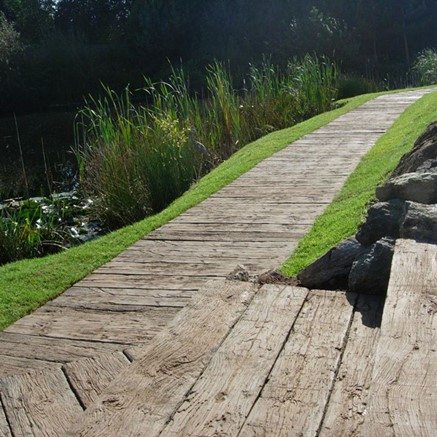
Considerations for design
When choosing the width and length of your decking boards, consider the design and layout of your outdoor space. For larger areas, longer and wider boards can create a more open and expansive feel. On the other hand, narrower boards can be used to design intricate patterns or accent specific areas of your deck.
Mixing board lengths
If you prefer a specific decking pattern or want to add visual interest to your design, consider mixing different board lengths for a more dynamic look. This will reduce waste by using shorter boards in specific areas, so it’s an all-round win!
How much decking do I need?
Accurately calculating the amount of decking boards you require will ensure a successful and cost-effective project. While it might seem like a complex and overwhelming task, we’ll break it down into simple steps for you, so the process is much more manageable.
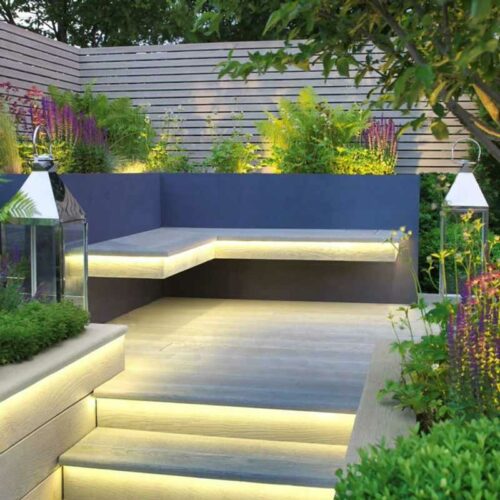
Step One: Break out the dimensions
Remember when we measured the area of your future deck space? Perfect. Grab those calculations because you’re going to need them! Don’t forget to account for your stairs, overhang and curve measurements if that’s what you’ve gone for.
Step Two: Pick your board size
Now’s the time to decide on the width and length of the decking boards you’ve got your eye on. Once you’ve made your decision, you can then calculate the area of a single board by multiplying the length by the width.
Step Three: Crunching board numbers
Divide your total square metres of the area from step one by the area a single board covers from step two. This will give you an estimate of how many boards you’ll need for your space. Don’t forget to round up to the nearest whole number to ensure you have enough material.
Step Four: Factor in waste
Now it’s time for a reality check! It’s always a good idea to make room for errors, so add a bit extra for waste, cutting and those “oops” moments. Adding about 10% to your calculations should do the trick. Multiply the number of boards from step three by 1.1 to give you a total of how many boards you need for your project.
There’s nothing worse than getting halfway through your project only to find that you don’t have enough material. Plus, you might find that if you’ve purchased your decking boards from different batches, there may be some colour variations, and your decking won’t look consistent if you buy more later. (Definitely not what you want!)
Step Five: Mind the gap
Plan for a gap between your boards. This will affect the final layout but give your decking enough space to breathe. (Don’t worry we’ll cover this bit next!)
Step Six: Check for pattern and layout
If you want to create specific patterns using different board lengths, consider how this will affect your calculations. Adjust the number of each board length accordingly. You might want to divide your area into manageable sections or even sketch it out on a piece of paper so you can visualise your layout.

What size gap should I leave between decking boards (mm) in the UK?
Don’t forget leaving space between your decking boards is essential to allow your boards to breathe. These gaps will enable your deck to deal with changes in temperature and moisture. A bit of space prevents water from pooling, reduces the risk of rot, and keeps your deck looking sharp. So, let’s have a look at the specifics of what size gap you should leave between your decking boards, measured in millimetres.
For the ideal deck gap, aim for a spacing of approximately 5-8mm between each board. This might not sound like much, but it’s the sweet spot that balances both function and aesthetics – not too wide, not too narrow.
If you’re decking it out with composite boards, remember that these materials can expand and contract a touch differently than natural wood. To account for this, you might want to lean towards the wider end of the gap range, around 8mm, to give your composite deck some flexibility.
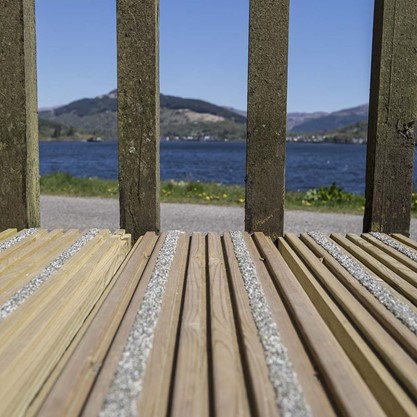
We’re sure you’re aware, our lovely UK weather can be a bit unpredictable at times. When installing your deck, consider the season and weather conditions. In wetter months, a slightly wider gap might be helpful to allow for better drainage.
How much is decking per m2 in the UK?
It’s natural to wonder about the financial side of things. After all, creating your dream outdoor space involves both creativity and budgeting. Let’s break down the cost and explore how much decking typically costs per square metre in the UK.
It’s important to note that the cost of decking can vary based on several factors, including material, quality and complexity of your deck’s design, not to mention labour costs and additional accessories and extras like screws, pedestals and preservative treatment coats.
Composite decking can cost anywhere in the region of £40 to £150 (sometimes more) per m² and is a highly durable, low-maintenance choice. You’ll find softwood decking is on the more affordable side, costing £30 to £60 per m² but won’t last as long. On the other hand, hardwood decking will be approximately £90 to £120 per m² and will add character to your deck but requires a bit more maintenance.
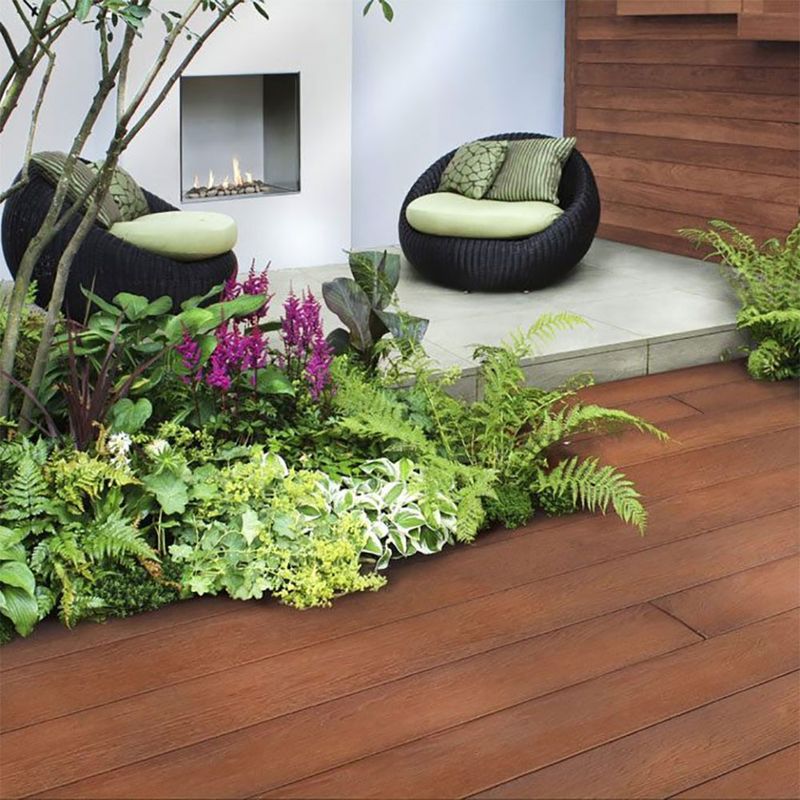
If you’re confident in your DIY skills, you can save on labour costs by tackling the installation yourself. However, keep in mind that building a deck requires careful planning and the right tools. (You’re halfway there with the planning!) But if you’re unsure, hiring professionals ensures a high-quality result.
Final thoughts
Transforming your outdoor space begins with envisioning comfort, style and functionality. This guide takes you through the crucial first steps of precise measurement techniques, board dimensions and gap considerations, so you can calculate how many decking boards you need. With these insights, you can turn your vision into a stunning outdoor reality.


















